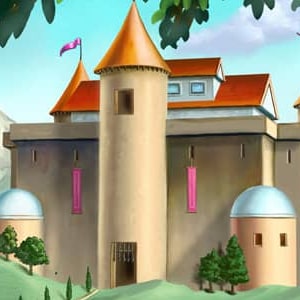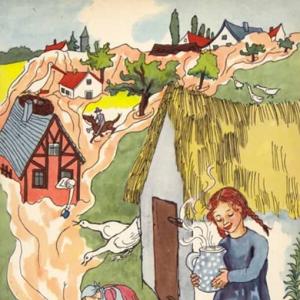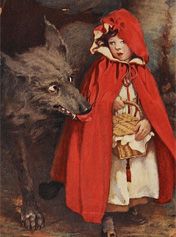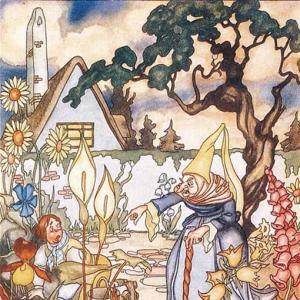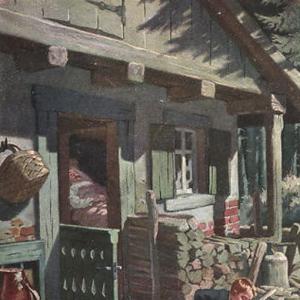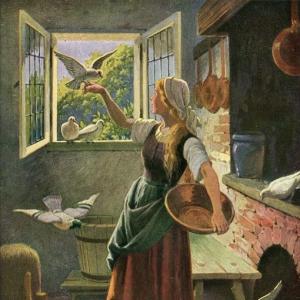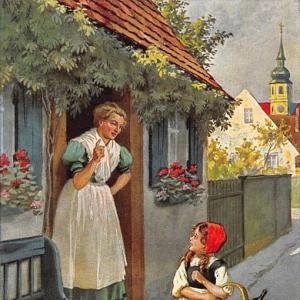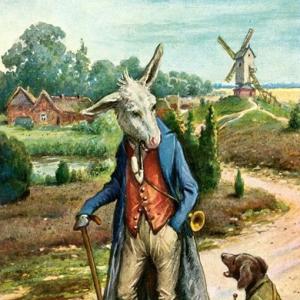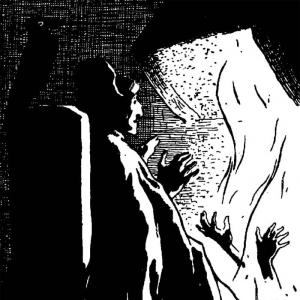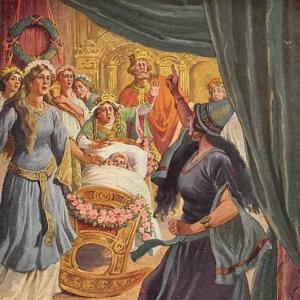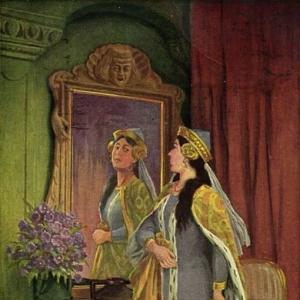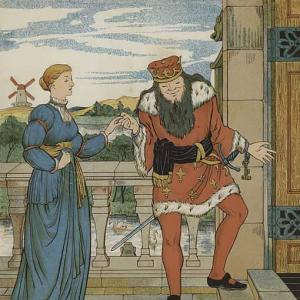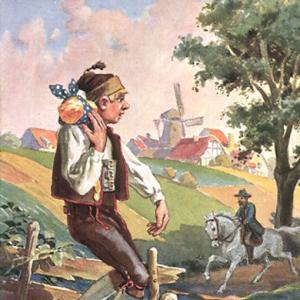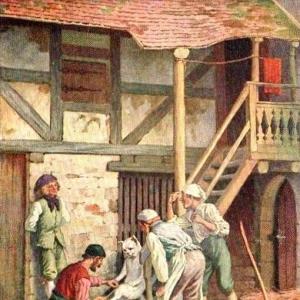Reading time for children: 7 min
A whipping top and a little ball lay together in a box, among other toys, and the top said to the ball, „Shall we be married, as we live in the same box?“
But the ball, which wore a dress of morocco leather, and thought as much of herself as any other young lady, would not even condescend to reply.
The next day came the little boy to whom the playthings belonged, and he painted the top red and yellow, and drove a brass-headed nail into the middle, so that while the top was spinning round it looked splendid.
„Look at me,“ said the top to the ball. „What do you say now? Shall we be engaged to each other? We should suit so well. You spring, and I dance. No one could be happier than we should be.“
„Indeed! do you think so? Perhaps you do not know that my father and mother were morocco slippers, and that I have a Spanish cork in my body.“
„Yes; but I am made of mahogany,“ said the top. „The major himself turned me. He has a turning lathe of his own, and it is a great amusement to him.“
„Can I believe it?“ asked the ball.
„May I never be whipped again,“ said the top, „if I am not telling you the truth.“
„You certainly know how to speak for yourself very well,“ said the ball. „But I cannot accept your proposal. I am almost engaged to a swallow. Every time I fly up in the air, he puts his head out of the nest, and says, ‚Will you?‘ and I have said, ‚Yes,‘ to myself silently, and that is as good as being half engaged; but I will promise never to forget you.“
„Much good that will be to me,“ said the top; and they spoke to each other no more.
Next day the ball was taken out by the boy. The top saw it flying high in the air, like a bird, till it would go quite out of sight. Each time it came back, as it touched the earth, it gave a higher leap than before, either because it longed to fly upwards, or from having a Spanish cork in its body. But the ninth time it rose in the air, it remained away, and did not return. The boy searched everywhere for it, but he searched in vain, for it could not be found. It was gone.
„I know very well where she is,“ sighed the top; „she is in the swallow’s nest, and has married the swallow.“
The more the top thought of this, the more he longed for the ball. His love increased the more, just because he could not get her; and that she should have been won by another, was the worst of all. The top still twirled about and hummed, but he continued to think of the ball; and the more he thought of her, the more beautiful she seemed to his fancy.
Thus several years passed by, and his love became quite old. The top, also, was no longer young; but there came a day when he looked handsomer than ever. For he was gilded all over. He was now a golden top, and whirled and danced about till he hummed quite loud, and was something worth looking at; but one day he leaped too high, and then he, also, was gone. They searched everywhere, even in the cellar, but he was nowhere to be found. Where could he be? He had jumped into the dust-bin, where all sorts of rubbish were lying: cabbage-stalks, dust, and rain-droppings that had fallen down from the gutter under the roof.
„Now I am in a nice place,“ said he; „my gilding will soon be washed off here. Oh dear, what a set of rabble I have got amongst!“ And then he glanced at a curious round thing like an old apple, which lay near a long, leafless cabbage-stalk. It was, however, not an apple, but an old ball, which had lain for years in the gutter, and was soaked through with water.
„Thank goodness, here comes one of my own class, with whom I can talk,“ said the ball, examining the gilded top. „I am made of morocco,“ she said. „I was sewn together by a young lady, and I have a Spanish cork in my body; but no one would think it, to look at me now. I was once engaged to a swallow; but I fell in here from the gutter under the roof, and I have lain here more than five years, and have been thoroughly drenched. Believe me, it is a long time for a young maiden.“
The top said nothing, but he thought of his old love; and the more she said, the more clear it became to him that this was the same ball.
The servant then came to clean out the dust-bin.
„Ah,“ she exclaimed, „here is a gilt top.“ So the top was brought again to notice and honor, but nothing more was heard of the little ball. He spoke not a word about his old love. For that soon died away. When the beloved object has lain for five years in a gutter, and has been drenched through, no one cares to know her again on meeting her in a dust-bin.
 Learn languages. Double-tap on a word.Learn languages in context with Childstories.org and Deepl.com.
Learn languages. Double-tap on a word.Learn languages in context with Childstories.org and Deepl.com.Backgrounds
Interpretations
Adaptions
Summary
Linguistics
„The Sweethearts“ is a fairy tale written by Hans Christian Andersen, a Danish author who lived from 1805 to 1875. Andersen is best known for his beloved fairy tales, including „The Little Mermaid,“ „The Ugly Duckling,“ „The Snow Queen,“ and „The Emperor’s New Clothes.“ His stories have been translated into more than 150 languages and have become an integral part of the world’s literary heritage.
Andersen’s fairy tales are often characterized by their emotional depth, moral messages, and sometimes dark themes. Although his stories were primarily written for children, they contain universal messages and appeal to people of all ages. Andersen’s stories often draw on his own experiences, exploring themes of love, loss, social status, and the passage of time.
„The Sweethearts“ is one of Andersen’s lesser-known works but still reflects his unique storytelling style and his ability to convey complex themes through seemingly simple tales. The story features anthropomorphized objects (the top and the ball) to explore the challenges of love and relationships, while also addressing broader themes related to social status, pride, change, and the unpredictability of life.
„The Sweethearts“ can be interpreted in various ways, highlighting themes of love, social status, pride, and the passage of time.
Love and its fragility: The story showcases the top’s unrequited love for the ball, which only grows stronger with time and distance. However, when they finally reunite, the top’s feelings for the ball fade away due to her changed appearance and circumstances. This could reflect the fragile nature of love and how it can be affected by superficial factors.
Social status and pride: The ball initially refuses the top’s proposal due to her pride in her background and her perceived engagement to a swallow. This highlights the importance of social status and how it can impact relationships. Additionally, the top’s increased attractiveness after being gilded demonstrates the power of appearances in shaping others‘ perceptions and actions.
The passage of time: The story spans several years, during which both the top and the ball undergo transformations. As time passes, the top’s love for the ball intensifies, and it becomes more attractive. In contrast, the ball’s circumstances worsen as it ends up in the dustbin, neglected and forgotten. This highlights the inevitability of change over time and the potential impact of these changes on relationships and feelings.
The fickleness of fate: The story demonstrates how circumstances can change unexpectedly and dramatically. Both the top and the ball experience moments of joy, love, and sorrow, illustrating the unpredictability of life. The tale reminds readers that fortune can be both kind and cruel, and that it is essential to be adaptable and resilient in the face of change.
Hans Christian Andersen’s fairy tale „The Sweethearts“ has been adapted in various forms over the years, including in literature, film, and theater. Here are a few examples of adaptations.
„True Sweethearts“ (1951): This Danish film, directed by Torben Anton Svendsen, is based on Andersen’s original story. It tells the story of Anne-Lise and Peter, two young lovers from poor families who face challenges and obstacles as they try to be together.
„The Faithful Lovers“ (1969): This episode of the British television series „Jackanory“ is an adaptation of Andersen’s story. It features narration by actor Bernard Cribbins and illustrations by Quentin Blake.
„Sweethearts“ (1986): This musical, with music by Victor Herbert and book and lyrics by Harry B. Smith, is loosely based on Andersen’s story. It tells the story of two young lovers who are separated and reunited years later, and features such popular songs as „Sweethearts“ and „Jeannette and Her Little Wooden Shoes.“
„The Sweethearts“ (2006): This play, written by Sarah Phelps, is a modern retelling of Andersen’s story. It tells the story of two young lovers who are separated when the boy is sent to fight in Iraq. The play explores themes of love, loss, and the impact of war on relationships.
„The Faithful Sweethearts“ (2014): This animated short film, directed by Yawen Zheng, is a modern interpretation of Andersen’s story. It tells the story of two young lovers who are separated when the boy is sent to work in a far-off city. The film explores themes of love, perseverance, and the power of friendship.
These adaptations demonstrate the enduring popularity and relevance of Andersen’s story, and its ability to be reinterpreted and adapted for new audiences and generations.
„The Sweethearts“ is a fairy tale by Hans Christian Andersen about a whipping top and a little ball who live together in a toy box. The top asks the ball if they should get married, but the ball, dressed in morocco leather and prideful, does not respond. The boy who owns the toys later paints the top with red and yellow, and adds a brass nail in its center, making the top more attractive. The top again proposes to the ball, who replies that it cannot accept the proposal as it is almost engaged to a swallow.
One day, the boy takes the ball outside, and it leaps high into the air, eventually disappearing. The top believes the ball has married the swallow and feels heartbroken. As time passes, the top’s love for the ball grows stronger, especially since it cannot have her. Eventually, the top becomes gilded, making it even more beautiful, and one day it leaps too high and ends up in the dustbin.
In the dustbin, the top meets an old, dirty ball that reveals it was once made of morocco leather and had been engaged to a swallow before ending up in the gutter. The top recognizes the ball as its old love but says nothing. A servant discovers the gilded top and takes it out of the dustbin, restoring its former glory, while the old ball remains in the dustbin, forgotten. The top does not speak of its old love, as the passage of time and the ball’s neglected state have caused its feelings to fade.
Hans Christian Andersen’s fairy tale „The Sweethearts“ presents a playful, yet poignant narrative that intertwines themes of romantic idealism, social class, and the fleeting nature of youth and beauty. Through a linguistic analysis, we can examine how Andersen uses language to explore these themes.
Characterization and Dialogue
Personification: Andersen uses personification to give life to inanimate objects— a whipping top and a little ball. This anthropomorphism allows for a satirical take on human behaviors and societal norms. The top’s earnest, somewhat naive nature is juxtaposed with the ball’s haughty demeanor.
Dialogue: The dialogue between the top and the ball is indicative of social class prejudices and romantic aspirations. The ball boasts about her heritage (“morocco slippers” and “Spanish cork”), suggesting a sense of superiority. In contrast, the top highlights his craftsmanship and the honor of being made by a „major“. This exchange mirrors the social class dialogues often found in human relationships.
Romantic Idealism: The top’s repeated attempts to win over the ball despite her disinterest underscores a theme of unrequited love. The top’s declarations and persistence reveal a romantic idealism that is both touching and ultimately futile.
Themes and Symbolism
Social Class and Materialism: The materials and crafting of the toys (morocco leather, Spanish cork, mahogany) symbolize different social strata. The ball’s rejection of the top mirrors real-world class dynamics, where material status influences social interactions and marriage prospects.
Fleeting Beauty and Vanity: The tale explores how beauty and charm can be fleeting. The top gains temporary prestige with his gilded appearance, much like the temporary allure of youth and beauty in human society.
Loss and Nostalgia: The narrative encapsulates a sense of nostalgia and loss. The top’s yearning for the ball after she disappears mirrors the human tendency to idealize what is unattainable or lost.
Language and Style
Irony and Satire: Andersen’s use of irony is evident in the ball’s engagement to a swallow and the eventual reunion in the dust-bin. Her lofty aspirations lead to a dismal end, poking fun at the folly of vanity and social climbing.
Descriptive Imagery: Andersen employs rich imagery to evoke the settings and emotional tone: the vibrant colors of the top, the vivid portrayal of the dusty, rain-soaked gutter. These descriptions enhance the contrast between the characters’ initial grandeur and their final destitution.
Narrative Voice: Andersen’s narrative voice maintains a light, whimsical tone throughout, yet with an undercurrent of melancholy. This balance creates a fairy-tale atmosphere while conveying deeper reflections on life and love.
In conclusion, „The Sweethearts“ is a multifaceted tale grounded in its linguistic execution. Through personified characters, satirical dialogue, and vivid imagery, Andersen crafts a narrative that reflects on the complexities of social class, the impermanence of beauty, and the bittersweet nature of romantic longing.
Information for scientific analysis
Fairy tale statistics | Value |
|---|---|
| Translations | EN, DA, ES, IT |
| Readability Index by Björnsson | 26 |
| Flesch-Reading-Ease Index | 88.6 |
| Flesch–Kincaid Grade-Level | 4.8 |
| Gunning Fog Index | 7.5 |
| Coleman–Liau Index | 6.4 |
| SMOG Index | 7.1 |
| Automated Readability Index | 4.3 |
| Character Count | 4.572 |
| Letter Count | 3.414 |
| Sentence Count | 57 |
| Word Count | 905 |
| Average Words per Sentence | 15,88 |
| Words with more than 6 letters | 92 |
| Percentage of long words | 10.2% |
| Number of Syllables | 1.092 |
| Average Syllables per Word | 1,21 |
| Words with three Syllables | 26 |
| Percentage Words with three Syllables | 2.9% |

